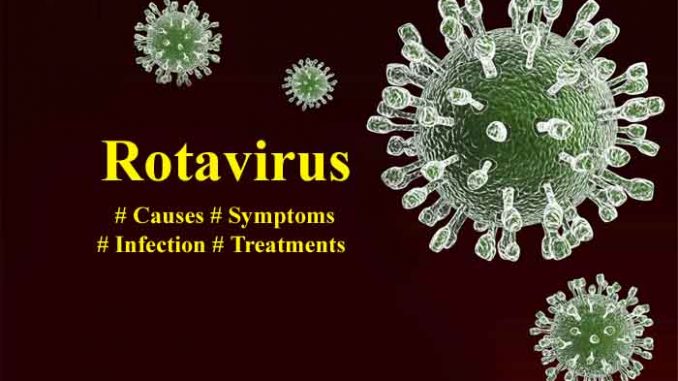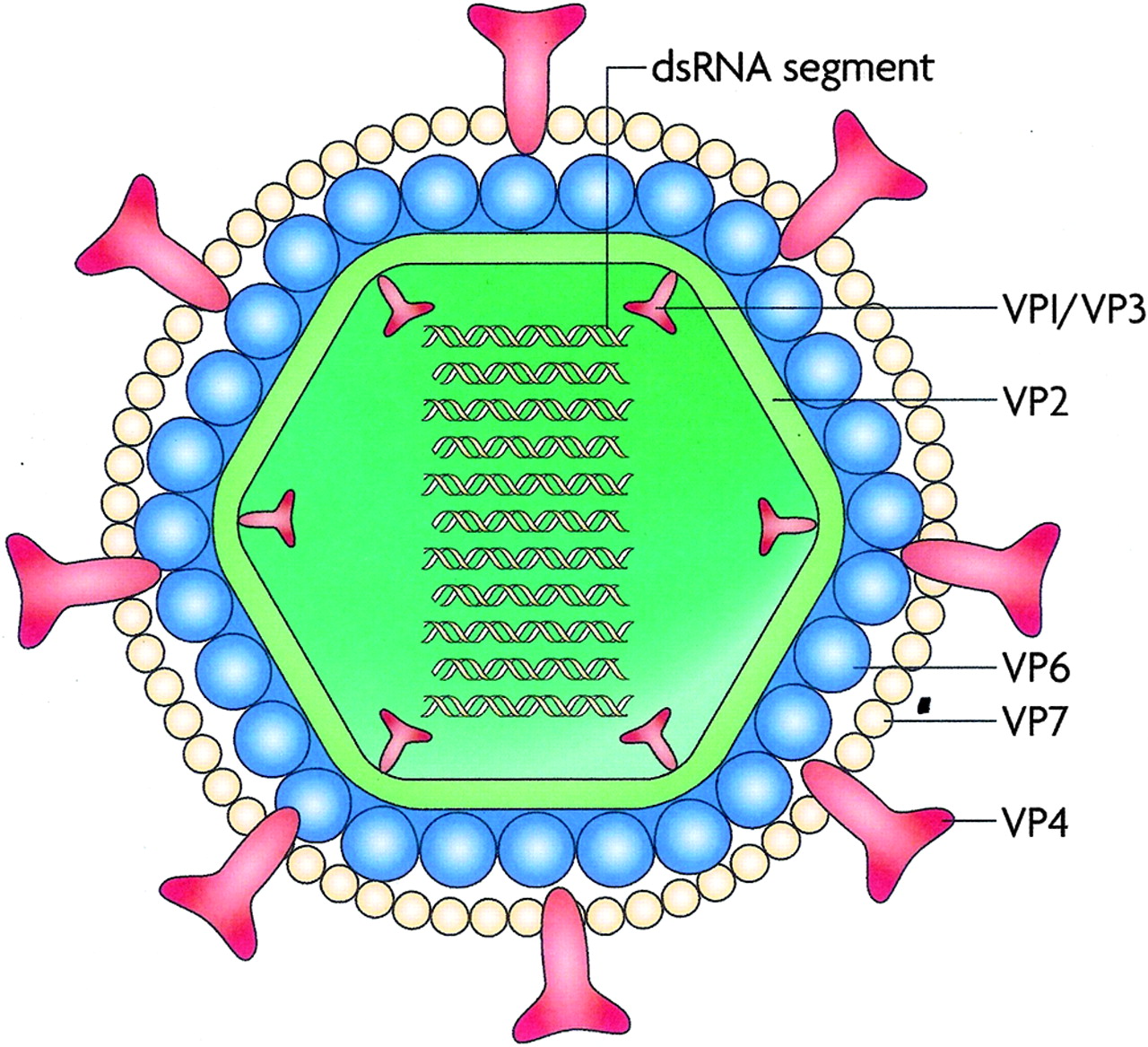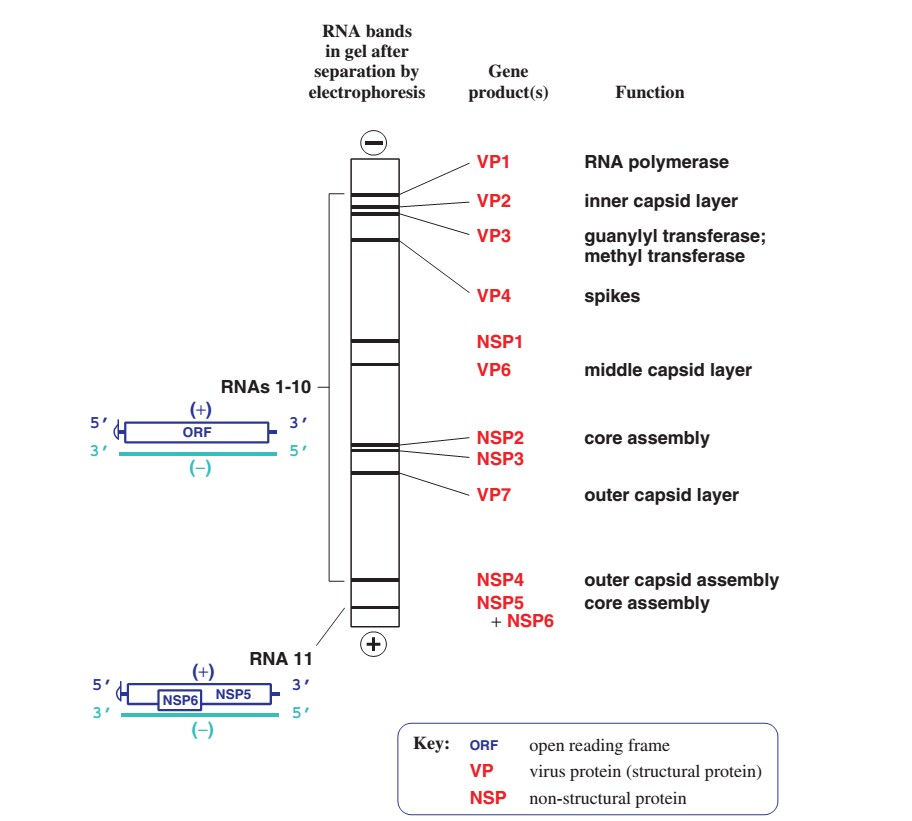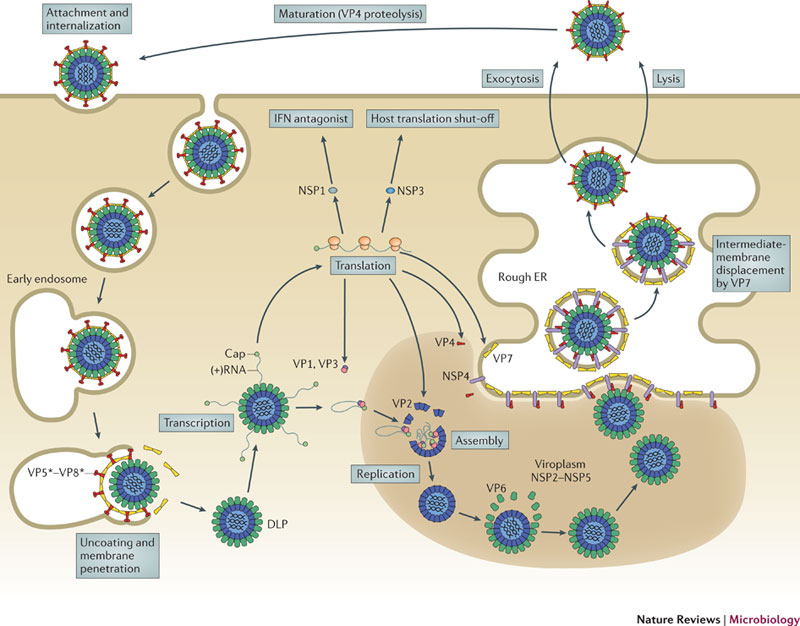
Rotavirus-Classification, Structure composition and Properties, Replication, Mode of Transmission, Pathogenesis, Clinical symptoms, laboratory diagnosis, Treatment, Prevention and Control
Rotavirus
- Family: Reoviridae
- Genus: Rotavirus
Classification of Rotavirus:
- Classified into seven distinct groups (A to G) based on structural antigen VP6.
- Group A, B, and C Rotaviruses are found in Human infection as well as animal infection
- Group A Rotaviruses are most frequent Human pathogen
Structure, composition and properties of Rotavirus
1. Structure:
Figure: Structure of Rotavirus
- Characteristics ”wheel” like appearance (Rota-means wheel)
- Size: 65nm-100nm in diameter
- Shape: Spherical shape
- Symmetry: Icosahedral
2. Genome composition:
- Genome: 11 segments of double stranded RNA (ds RNA )
- Protein: 6 structural protein (VP) and 6 Non-structural protein (NSP)
- Envelope: Absent
- Nucleic acid is surrounded by two layer of capsid- inner capsid (VP6) and outer capsid (VP7)
- VP4 is the spike protein, it is a cell surface receptor
 Figure: 11 segments of genome of Rotavirus
Figure: 11 segments of genome of Rotavirus
3. Other properties
- Replication: Occurs in cytoplasm of infected cell.
- Rota virus contain an RNA-dependent RNA polymerase and other enzymes capable of producing capped RNA transcripts
- Rota virus do not grow in cell line culture
Rotaviruses are inactivated by-
- Heating to 100°C
- Treatment with acid (pH<3),
- Glutaraldehyde (3%),
- Phenol,
- Formalin,
- Chlorine
- Alcohol (70%),
Replication of Rota virus:
- Attachment: by VP4 on cell surface receptor
- Penetration: receptor mediated endocytosis
- Un-coating in lysosome
- Transcription is mediated by endogenous virus dependent RNA polymerase (transcriptase)
- Translation to produce viral structural protein
- Synthesis of full length transcript
- Some of the full length transcript are encapsidate
- Synthesis of –ve sense RNA strand with capsid to form ds RNA
- Formation of inner capsid
- Morphogenesis: budding of single shelled virus into RER acquiring pseudo envelope
- Removal of pseudo envelope and replaced by outer capsid in RER
- Maturation
- Cell lysis and Release

Figure: Replication cycle of Rotavirus
Mode of Transmission:
- Ingestion of contaminated food and water
- Directly from faeces contaminated fingers
- Occasionally by droplet infection
- Children below 5 years are mostly affected
- Adults are infected by contact with pediatric cases
Incubation period: 2-3 days
Pathogenesis:
- Rota virus replicates in enterocyte near the tip of villi destroying enterocytes
- Viral encoded toxin: early profuse, secretory diarrhea is caused by enterotoxin, NSP4.
- Disruption of intestinal epithelium due to virus replication
- Histologic changes of enterocytes that triggers enteric nervous system, intestinal secretion and immune response
- The acute infection and diarrhoea normally resolves within 7 days in immunocompetent hosts.
Clinical symptoms:
-
Local infection:
- Acute Gastroenteritis, severe in case of infants aged 6-24 months.
- Infected Infants are unable to digest milk due to lactase deficiency caused by destruction of enterocytes
- Diarrhoea, nausea and vomiting
- Malabsorption of Na+, water, and disaccharides
- Symptoms of Dehydration: decrease in urination, dry mouth and throat and feeling dizzy when standing up.
2. Systemic infection:
- High grade Fever
- Lymphocytosis and transient neutropenia.
3. Complication:
- Febrile Convulsion in small children
- Severe dehydration, hypotonia and shock
Laboratory diagnosis:
Specimen: faeces in early infection,
- Viral antigen detection: solid phase agglutination, ELISA
- Electron microscopy
- EIA (enzyme immune assay): it is sensitive to detect virus in stool
- Dip stick/ rapid test
- PCR: For genotyping of Rotavirus
- Virus culture: No cell line culture
Treatment:
- Oral rehydration
- Other supportive rehydration therapy to control loss of water and electrolytes
- Vaccine: Two Oral rotavirus vaccines are currently licensed for use in infants
- RotaTeq® (RV5) is given in 3 doses at ages 2 months, 4 months, and 6 months
- Rotarix® (RV1) is given in 2 doses at ages 2 months and 4 months
Prevention and control:
- Sanitation
- Waste water treatment
- Health professional should wash their hands with soap and water before and after patient contact.
References
- https://medlineplus.gov/rotavirusinfections.html
- www.immune.org.nz/diseases/rotavirus
- http://www.mayoclinic.org/diseases-conditions/rotavirus/symptoms-causes/dxc-20186931
- http://www.webmd.com/children/vaccines/tc/rotavirus-topic-overview#1
- https://en.wikipedia.org/wiki/Rotavirus
- http://www.medicinenet.com/rotavirus/article.htm
- https://www.cdc.gov/rotavirus/about/treatment.html
- https://researchspace.auckland.ac.nz/handle/2292/1286
- https://www.ncbi.nlm.nih.gov/pmc/articles/PMC372748/
- http://www.fbae.org/2009/FBAE/website/special-topics_general_issues_rotaviruses.html

it is nice